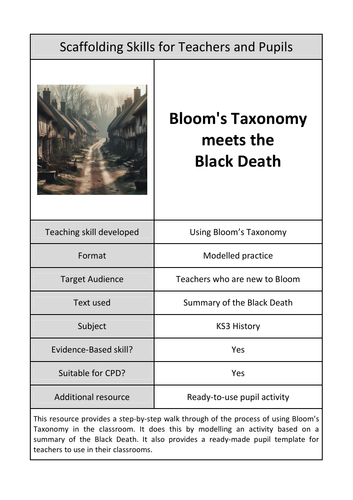

This resource provides an excellent model for implementing Bloom’s Taxonomy through a classroom-ready activity on the Black Death for KS3 History students. It comprehensively covers each level of the taxonomy through clear explanations, sample questions, and opportunities for students to generate their own questions.
The resource begins by outlining the benefits of using Bloom’s Taxonomy, such as promoting higher-order thinking skills, scaffolding learning progressively, and providing a framework for creating assessments. It highlights how the taxonomy equips students with vital 21st century skills like analysis, problem-solving, and creativity.
The core of the resource walks through the six levels of Bloom’s - remembering, understanding, applying, analysing, evaluating, and creating. For each level, it gives a simple explanation of what that cognitive skill involves. It then provides multiple sample questions related to the Black Death summary that model what questions at that level look like. Crucially, it explains why each sample question exemplifies that particular thinking skill level.
An engaging element is that the resource prompts both teachers and students to practise writing their own questions for each taxonomy level based on the text. This interactive aspect reinforces understanding of the levels while involving students actively.
Throughout, the resource uses the summary on the Black Death as a grounded, subject-specific context for exploring Bloom’s Taxonomy in a meaningful way. Having a concrete text example makes the hierarchy of thinking skills more tangible.
The resource conveniently includes a ready-to-use student handout template covering all the taxonomy levels and aligned to the Black Death text. This allows teachers to easily implement the activity in their classroom with little extra preparation required.
Overall, this resource provides a comprehensive, practical and engaging guide for KS3 History teachers to start incorporating Bloom’s Taxonomy into their lessons. Its clear structure, modelled examples and built-in student materials offer an accessible way to put this powerful framework for fostering higher-order thinking skills into practice.
Something went wrong, please try again later.
This resource hasn't been reviewed yet
To ensure quality for our reviews, only customers who have purchased this resource can review it
Report this resourceto let us know if it violates our terms and conditions.
Our customer service team will review your report and will be in touch.